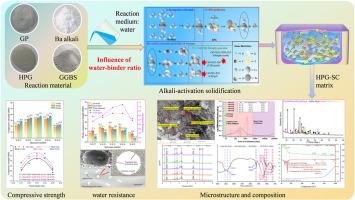Ba(OH)2-activated hemihydrate phosphogypsum-based slag concrete: Influence of water-binder ratio on compressive strength, water resistance and microstructure
IF 5.8
2区 化学
Q2 CHEMISTRY, MULTIDISCIPLINARY
引用次数: 0
Abstract
The quaternary cementitious system exhibited better performances and optimizing water-binder ratio was a low energy consumption approach to improve the properties of cementitious materials. This study presented an innovative quaternary cementitious system of Ba(OH)2-activatied hemihydrate phosphogypsum-based slag concrete(HPG-SC) to achieve the modification mode of Ba alkali on HPG-SC “primary modification” + “secondary activation”. The experiments were conducted on HPG-SCs to reveal the effects of water-binder ratio on compressive strength, water resistance and microstructure of HPG-SC. The experimental results showed that compressive strength and water resistance increased firstly and then decreased as the water-binder ratio increased from 0.27 to 0.39. The 28-day compressive strength and air-dried softening coefficient of W-0.33 were 34.8 MPa and 0.85, respectively. The effect mechanisms of water-binder ratio were explained from the micro-morphologies, pore diameter and porosity. The water-binder ratio adjusted the hydration rate of cementitious system to increase the compactness and compressive strength. Moreover, the lowest first peak diameter was observed and the lower porosity was 43.32 % in W-0.33 specimen. Therefore, HPG-SC showed better compressive strength and water resistance at the suitable water-binder ratio, and was beneficial for the application in construction engineering.

Ba(OH)2活化半水磷石膏渣基混凝土:水胶比对抗压强度、抗水性和微观结构的影响
第四系胶凝体系表现出较好的性能,优化水胶比是提高胶凝材料性能的低能耗途径。本研究提出了一种创新的Ba(OH)2活化半水磷石膏基渣混凝土(HPG-SC)四元胶凝体系,实现了Ba碱在HPG-SC上的“一次改性”+“二次活化”改性模式。以HPG-SC为实验材料,研究水胶比对HPG-SC抗压强度、耐水性和微观结构的影响。试验结果表明:随着水胶比从0.27增加到0.39,混凝土的抗压强度和抗水性先升高后降低;W-0.33的28天抗压强度和风干软化系数分别为34.8 MPa和0.85。从微观形貌、孔径和孔隙度等方面解释了水胶比的影响机理。水胶比调节了胶凝体系的水化速率,提高了胶凝体系的密实度和抗压强度。W-0.33试样第一峰直径最小,孔隙率较低,为43.32%。因此,在合适的水胶比下,HPG-SC具有较好的抗压强度和耐水性,有利于在建筑工程中的应用。
本文章由计算机程序翻译,如有差异,请以英文原文为准。
求助全文
约1分钟内获得全文
求助全文
来源期刊

Sustainable Chemistry and Pharmacy
Environmental Science-Pollution
CiteScore
8.20
自引率
6.70%
发文量
274
审稿时长
37 days
期刊介绍:
Sustainable Chemistry and Pharmacy publishes research that is related to chemistry, pharmacy and sustainability science in a forward oriented manner. It provides a unique forum for the publication of innovative research on the intersection and overlap of chemistry and pharmacy on the one hand and sustainability on the other hand. This includes contributions related to increasing sustainability of chemistry and pharmaceutical science and industries itself as well as their products in relation to the contribution of these to sustainability itself. As an interdisciplinary and transdisciplinary journal it addresses all sustainability related issues along the life cycle of chemical and pharmaceutical products form resource related topics until the end of life of products. This includes not only natural science based approaches and issues but also from humanities, social science and economics as far as they are dealing with sustainability related to chemistry and pharmacy. Sustainable Chemistry and Pharmacy aims at bridging between disciplines as well as developing and developed countries.
 求助内容:
求助内容: 应助结果提醒方式:
应助结果提醒方式:


